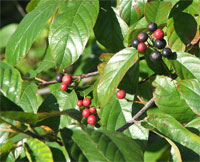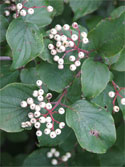Native Plant Road Trip to Decatur

Classic gas pumps at the Petrified Wood gas station in Decatur.
All photos by Steven Chamblee.
Pearls and Steel
I’ve always loved pearls … both literally and metaphorically. The very idea that a slimy blob of an organism stuck in a shell can take an irritating piece of grit and turn it into one of the most beautiful things on Earth … well, it inspires me to think there’s hope even for me. People all over the world appreciate the simple beauty and elegance of pearls, and value that little blob for both its talents and its taste. (And now that I think about it, it means someone may well figure out how to make big ol’ hairy me gorgeous as well. But I digress….)
Sitting here at the stone writing desk in my garden, listening to the train whistle in the distance — (remember Paul Simon’s great line: "Everyone loves the sound of a train in the distance; everybody thinks it’s true"?… but I digress …) I find pearls all around me. Ten feet to my left, a Carolina buckthorn (Frangula caroliniana) is putting on its annual crop of red and black pearl-like fruit. They all start out green (ohhhh … and don’t we all?), then turn red, then finally mature to perfect black pearls suspended on delicate stems. Also known as Indian cherry, this lovely small tree grows to about 15 feet, generally as an understory tree or at forest’s edge. Mine is out in full sun now, but originally grew at the base of an oak that succumbed to oak wilt in 2001. Fall color has begun to blush in the leaves now, with a few hints of rust and red this year. Most years, autumn turns it a lovely golden yellow.
Like the pearl, Carolina buckthorn has a mystery of its own. Closely related to the genus Rhamnus, the plant has bark, leaves, and fruit that contain purgative chemicals, making it an effective cathartic, so don’t eat or make tea with it. I have always found the relationship between the word catharsis and its relative, cathartic, quite interesting — the former being a wonderful cleansing of the mind that allows us to break free of the past and treasure our future, and the latter being a rather abrupt cleansing of the body that usually accomplishes the same result. (Hmmm … seems like I had a similar discussion at the lunch table back when I worked at the Heard Museum. Hey, true scientists can discuss anything at the lunch table … oops, once again, I digress.)
So I’m sitting here writing about this stuff, when a small bird lands on the pokeberry, a few feet past the buckthorn. Purple pearls. A plethora of pretty purple pearls … pendant upon a perfectly pleasant perennial plant with plenty of poison in its leaves unless properly prepared by people to whom the process is perfunctory. Okay, so it’s another “enjoy without eating” plant, unless you are a bird or a deep swamp Cajun, then it’s smorgasbord time. Pokeberry (Phytolacca americana) is a large herbaceous perennial that ranges from about Abilene to the Atlantic, and grows 4 to 10 feet tall. Personally, I like the plant for its Jekyll-and-Hyde act. From April to July, lots of folks ask why I have such a rangy weed in my garden. From July to first freeze, the same people say, “Wow! That’s the most gorgeous thing I’ve ever seen! Where do I get one?” My advice is to find one now, collect a few fruits and drop them in a hole where you want it, and wait until late spring. Shazam! Pinching keeps it compact; wash your fingers afterward.
One of my chickens over by the fence attracts my attention, as if to direct me to … another pearl. This time it’s roughleaf dogwood (Cornus drummondii). I love this four-season plant, which is tough enough to do the fenceline fandango all over the eastern half of Texas. The red-tinged twigs are quite lovely in winter, especially when wet, and since the plants tend to form thickets, there can be lots of twigs. Spring brings large clusters of tiny white flowers that do not resemble a "regular" dogwood at all, but are undeniably beautiful. In summer, those dark green, “rough” leaves (due to a layer of sometimes/sometimes-not bristly hairs) wear well in the blazing heat, keeping the plant nice and tidy looking. Fall brings on the two-tone season — white “pearl” fruits and red to purple foliage. Most years, the fruits are dropping off by the time the foliage is fully colored, but sometimes things get lined up nicely.
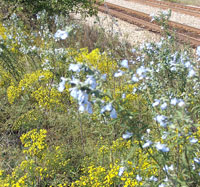
Azure sage, broom, and railroad tracks east of Decatur
So last week I’m standing out in the field sandwiched between Hwy. 287 and the railroad tracks just east of Decatur, wind a-blowin’ and semi trucks a-honkin’, trying to take a decent shot of this azure sage (Salvia azurea). Gorgeous plant. Sky-blue blossoms with a little spot of puffy-cloud white right in the middle. The leaves are about 3 inches long and relatively skinny, but what’s cool is how they are so neatly organized in straight lines up the stem. Type A’s can rejoice. The lovely yellow background was provided by an invasive species of broom, which, lovely as it is in flower, is an ecological nightmare … but that’s another story.
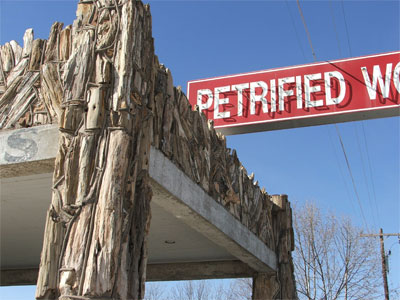
The Petrified Wood gas station
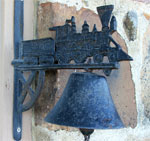
Whistlestop Cafe doorbell
A few miles down the road, a tourist-tolerant businessman has lovingly restored the old Petrified Wood Gas Station. While the pumps won’t give you any of that 15.9 cents/gallon petro anymore, you can still feel vibes that surrounded this site 60 years ago. Behind the station, an old motor court still stands, with ammonites and other wonders cemented right into the arches. Visit at breakfast or lunchtime, and you can eat at the Whistlestop Cafe next door. Classic diner faire, served up with plenty of smiles and "Sugar." If you listen closely, you might still hear Benny Goodman playing on a radio back in the kitchen.
Back at my writing table, I can now hear another train a-comin’ … which reminds me of a pearl of metaphorical wisdom once uttered by Will Rogers: “Even if you’re on the right track, you’ll get run over if you just sit there.” I believe ol’ Will was right; after all, he is also the author of my other favorite quote, one that has saved my life more than once: “Never pass up a good opportunity to keep your mouth shut.”
Peace & love,
Steven
About the author: Steven Chamblee is the chief horticulturist for Chandor Gardens in Weatherford and a regular contributor to Neil Sperry’s GARDENS magazine and e-gardens newsletter. Steven adds these invitations:
Fall into autumn color at Chandor Gardens. We have made lots of changes this past year, so if you haven’t seen Chandor Gardens lately, you just haven’t seen Chandor Gardens! We’ve got heirloom color plants, waterfalls, fountains, sculpture, grottoes, a labyrinth, and more. You can go to the website (www.chandorgardens.com) for a preview and call 817-613-1700 for reservations and more information. Combine your Chandor trip with a visit to nearby Clark Gardens for a full day of blooms and beauty.
A little help from my friends…. I still need some destinations for my Texas road trips! If you would like me to speak to your garden club or group, just shoot me an e-mail at schamblee@weatherfordtx.gov to make arrangements. I’m inexpensive and low maintenance, and you know I love to go just about anywhere, so let me know. No city too big; no town too small. As long as it has a Farm to Market road nearby, I’m in.


